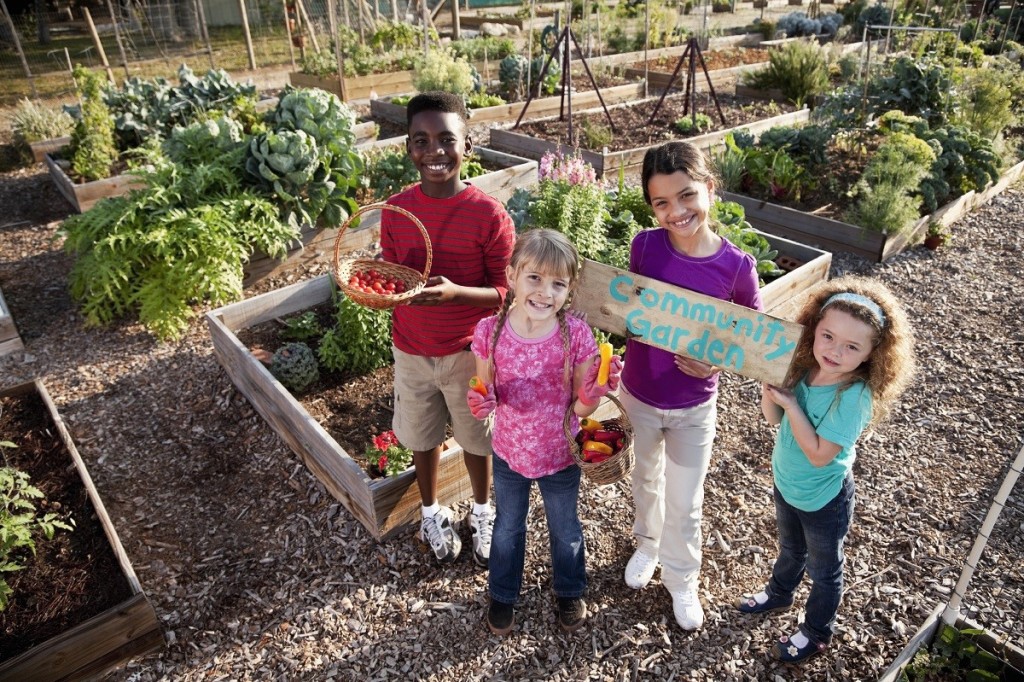
One of the best trends sweeping across Canada and the U.S. is the growth of community and school gardens (also referred to as urban gardens or urban farming). They are sprouting up everywhere. Individuals, schools, neighborhood organizations, and municipalities alike are heralded for their respective parts in driving such initiatives forward to the benefit of healthier self-sustaining communities. The Plant a Seed & See What Grows foundation is doing all that it can to further spark these movements, including providing tips of how to start a community garden in your very own locale. As the spring season arrives we thought to follow-up with some additional advice that will help you grow a successful organic garden in your neighborhood, focusing on the best types of seeds to plant (varying by moderate climates). Read further to learn more.
5 Plants That Respond Well to a Community Garden Environment
1. Strawberries
Strawberries are a great addition to any organic community garden throughout North America. It’s easy to get your younger helpers behind this produce item (what child doesn’t love strawberries?) and they simply look great growing in your neighborhood plot. More importantly, strawberries grow well in various climates, especially everbearing (blooming from early summer into the autumn) varieties such as Quinault, Seascape, Tribute and Tristar. In most regions in Canada, early spring planting is recommended. However community gardens in southern (U.S.) regions such as California and Florida (which have warmer winters) are advised to plant in the autumn. Make sure that seeds are planted in a spot that receives 8 to 10 hours of daylight/sunlight with one inch of watering per week at the root zone. Within one month of blooming, ripe strawberries begin to appear. You can harvest them from your garden once a lush red color is evident and your taste buds validate them for picking.
2. Kale
This nutritious green is perfect for cooler climates as found in the northern portion of the continent. You’ll notice kale popping up in many community gardens of late, especially in the health-conscious (and cooler) Pacific Northwest. That being said, kale can still be grown successfully in most North American climates and is easy enough to manage for any community garden project. Because this annual plant can handle the cold season (in as temperatures as low as 20 °F / -6 °C) you can get started in nearly any season and have it ready for harvesting a year later. If planting in the cold season, select a community garden plot that will receive the most sunlight. If planting in the warm season, select a spot that receives partial shade. No matter the temperature, kale responds well to moisture so ensure that the soil is watered frequently – the more moist the soil the sweeter and crisper the leaves produced for harvesting. Once the leaves are approximately 8 to 10 inches above the soil you can begin picking. Kale is also quite good at resisting disease and insect infestation, thus, the only real precautions that you need to take there are to make sure that you pick up any weathered leaves surrounding the soil.
3. Radishes
Radishes are among the easiest plants/vegetables to grow, which is why we also included them in our recent article on the best options for indoor gardening. They too are a cool season crop. In fact, frost improves flavor and texture of most winter varieties such as such as China Rose and Long Black Spanish. They are very popular for those community gardens maintained in-part by children/students because they grow fast (perfect for short attention spans) and can be harvested within three to six weeks. When planted during a cool season you will want to ensure maximum exposure to the sun. When planted in the summer months selecting a partially shaded area is recommended. Soil should remain moist and thus frequent watering is required. Radishes in any community garden equal a quick and satisfying payoff.
4. Snow Peas
Snow peas are another great candidate for community gardens in multiple climates (its name is a bit of a giveaway). In particular, the Oregon Snow Pea grows best in both warm and cool regions, as found in a recent study. You can start planting snow peas any time of the year in warmer climates and as soon as the snow has melted in colder climates, which you can harvest in just over three months. One of the best parts about growing snow peas in a community atmosphere is that they can be eaten right out of the picked pod while in the garden – something that gets kids excited about the prospect. In addition, the more regularly you harvest them the more likely you will increase your total yield. Simply put, the more you pick the more a snow pea plant will produce and that makes perfect sense for a community garden. One important note to mention is that snow peas are vining plants, and are thus easier to manage when they climbing up a trellis – so try accordingly.
5. Blueberries
We thought we’d throw a “long game” entry into this list for good measure. While quick-growing plants help get a community garden off of the ground it is also a great idea to consider the long term success of the project which will bear fruit for the generations ahead. Not to mention, we’d hate to exclude this tasty and antioxidant-rich yield which can also be grown well in many climates. The only caveat is the soil conditions required, which is easy enough to work around with the right guidance. For blueberries to thrive, the soil must be well aerated, moist, high in humus, and very acidic, so be sure to account for this on your “shopping list” before visiting to your local gardening center. Before selecting which blueberries you will plant, consider your climate. Highbush or Rabbiteye blueberries are great for warmer southern climates, while Lowbush or Half-High blueberries grow well in regions with freezing winter temperatures.
There is of course much more to consider before planting any of the above in your community garden, so be sure to follow the instructions on the seed packets that you purchase and discuss options with the gardening expert that you purchase them from. Otherwise, some additional online research for each produce item listed above will go a long way. Our intent here, is to get you started off on the right track by selecting the right types of fruits/vegetables to plant in your neighborhood’s organic plot.
Are you proud of your community garden? Follow us on Facebook here and send us an instant message telling us all about it. We’d be happy to share photos and links to your community gardening efforts on our social networks and perhaps even feature it here on the Plant a Seed & See What Grows blog. Happy Planting!







